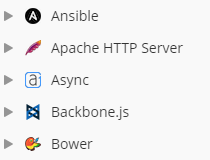

#Devdocs client update
Println(data) # <- insert this lineĪnd update it, you should find that the next time you evaluate you see the contents of the current editor dumped into the console. For example, if you modify the eval handler as follows: handle("eval") do data

If you change a handler, just press C-Enter to update it in place you should see the effect of your update immediately next time the handler is triggered. Evaluating handlers from within the Atom module will show you what message types are currently defined. If you open a file from the Atom.jl source code, you should see from the status bar that Juno knows you're working with the Atom module (try evaluating current_module() if you're not sure). You don't need to reload Atom or restart the Julia client every time you make a change like this. Modifying say, the completions handler in a similar way will show you what completion data Julia sends back to Atom (there will probably be a lot, so try looking at specific keys, for example). This will show you both the data being sent to Julia (in the example above, Dict("code"=>"2+2")) and the data being sent back to Atom ( Dict(:result => 4)). For example, it's easy to change the above Julia handler to handle("eval") do Dict(:result => eval(parse(data))) This mechanism is how Julia commands like lect() are implemented, and in general it makes it very simple for Julia to control the Atom frontend – see frontend.jl and ffee Debugging and LearningĪ good way to get a handle on this stuff is just to use console.log and on the Atom and Julia sides respectively, to take a peek at what's going over the wire.
#Devdocs client install
Or install it by downloading the zip, extract it and put it into the package dir of sublime. Open Command Palette using menu item Tools Command Palette. Try changing the handler to modify the data before returning it. The easiest way to install is using Package Control, where Sublime-devdocs is listed as Devdocs offline. The data was passed to Atom and simply returned as-is.
#Devdocs client code
(It's very easy to add this code to julia-client's activate function if you want to try this out.)Ĭalling the following from the REPL: echo(Dict(:a=>1, :b=>2)) It's also possible for Julia to wait for a response from Atom, using the rpc function. Handlers are defined on the Atom side as follows: client.handle 'log', (args.) ->

Julia has a similar mechanism to talk to Atom via the function type(args.) (You'll want to use a type other than eval to avoid clashes with actual evaluation.) Sending messages from Julia This approach is exactly how Atom gets evaluation results, autocompletion and more from Julia – so it's easy to find more examples spread throughout the julia-client and Atom.jl source code.Īs a first project, try implementing an Atom command (see the Atom docs) which sends this message to Julia, as well as adding the Julia handler above to Atom.jl. This call sends the eval message, pulls the result field out of the returned JSON, and displays the result, 4, in the console. We don't need to change anything on the Julia side to accomplish this we can just use the rpc function from JS: client.rpc('eval', '2+2').then (result) => Often we want to do something with that return result in Atom – in this case, we'd like to display the result. It simply evaluates whatever it's given and returns the result – in this case, 4. This is a very simplified version of the eval handler that you can find in the Atom.jl source code. There is 1 other project in the npm registry using devdocs-client. Start using devdocs-client in your project by running npm i devdocs-client. On the Julia side, we need to set up a handler for this message, which happens as follows: handle("eval") do code Latest version: 0.1.0, last published: 4 years ago.

For example, on the Atom side messages are sent in CoffeeScript as follows: client.msg 'eval', '2+2' The handler then takes some action and returns data to the original sender. Sending messages from AtomĬommunication works by sending messages with an appropriate type on one side and registering handlers for that type on the other. However, the details of those files aren't particularly important – you only need to understand the communication API, which we'll go over here. The code handling low-level communication is kept in ffee and comm.jl. Messages are JSON objects, with a type header to tell the receiver how the message should be handled. When Julia starts it connects to Atom over a TCP port, and from that point on Julia and Atom can each send messages to each other. The final result of the callback is returned as a promise.Juno works by booting a Julia client from Atom. Fetching data # resolved #Īccepts a callback, which will be recursively executed, until the data has been fetched (or an error occurs). GQty is a framework-agnostic GraphQL client, and can be used anywhere (we might add more bindings for other Frontend frameworks in the future). gqty refers to the generated directory.


 0 kommentar(er)
0 kommentar(er)
